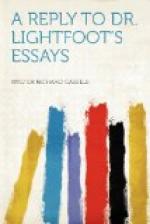It is difficult to recognise in this fancy portrait the Basilides regarding whom a large body of eminent critics conclude that he did not know our Gospels at all, but made use of an uncanonical work, supplemented by traditions from Glaucias and Matthias; but, as if the heretic had not been sufficiently restored to the odour of sanctity, the additional touch is given in the passage more immediately before us. Dr. Westcott conveys the information contained in the single sentence of Clement of Alexandria, [Greek: kathaper ho Basileides kan Glaukian epigraphetai didaskalon, hos auchousin autoi, ton Petrou hermenea], [19:1] in the following words; and I quote the statement exactly as it has stood in my text from the very first, in order to show the inverted commas upon which Dr. Lightfoot lays so much stress as having been removed. In mentioning this fact Canon Westcott says: “At the same time he appealed to the authority of Glaucias, who, as well as St. Mark, was ‘an interpreter of St. Peter.’ [19:2] Now we have here, again, an illustration,” &c.; and then follows the passage quoted by Dr. Lightfoot. The positive form given to the words of Clement, and the introduction of the words “as well as St. Mark,” seem at once to impart a full flavour of orthodoxy to Basilides which I do not find in the original. I confess that I fail to see any special virtue in the inverted commas; but as Dr. Lightfoot does, let me point out to him that he commences his quotation—upon the strength of which he accuses me of “manipulating” a passage, and then founding upon it a charge of unfair dealing—immediately after the direct citation from Dr. Westcott’s work, in which those inverted commas are given. The words they mark are a quotation from Clement, and in my re-quotation a few lines lower down they are equally well indicated by being the only words not put in italics. The fact is, that Dr. Lightfoot has mistaken and misstated the whole case. He has been so eagerly looking for the mote in my eye that he has failed to perceive the beam which is in his own eye. It is by this wonderful illustration that he “exemplifies the elaborate looseness which pervades the critical portion of this (my) book.” [19:3] It rather exemplifies the uncritical looseness which pervades his own article.




